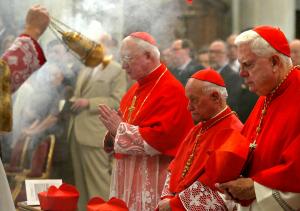Issue Date: June 6, 2003
Liturgy at papal basilica seen as Vatican gesture or reconciliation with Catholic traditionalists By JOHN L. ALLEN JR. In his highest-profile return to the public stage since his Dec. 13 resignation, Cardinal Bernard Law took part in a much-anticipated Mass May 24 in Rome’s Basilica of St. Mary Major. The occasion was equally rare: the first Mass celebrated in Latin, according to the rite in use prior to the Second Vatican Council (1962-1965), by a cardinal in a major papal basilica since 1970. Cardinal Dario Castrillón Hoyos, a Colombian who heads the Vatican’s Congregation for Clergy, said the Mass. Law was one of five other cardinals dressed in crimson liturgical vestments, including a traditional biretta, and seated in the front row. Another American cardinal and a good friend of Law, William Baum, former archbishop of Washington, was also in attendance. Law told NCR before the Mass that he was in Rome for meetings of two Vatican congregations of which he is a member. (His Dec. 13 resignation was as archbishop of Boston, and he remains a member in good standing of seven congregations and two councils.) After the Mass, Law brush-ed reporters aside, saying only, “I thought it was a very moving Mass.” Asked if he could comment on his post-resignation situation, he said, “I really haven’t been doing that.” The Latin Mass, celebrated according to a rite codified by the mid-16th-century Council of Trent, was replaced in the Catholic church in 1969 with the so-called “new Mass,” which is celebrated in vernacular languages. In the years since, a determined movement of liturgical traditionalists has clamored for the reinstatement of the “old Mass.” In 1988, French Archbishop Marcel Lefebvre led his St. Pius X movement, made up of devotees of the old Mass, into a formal break with Rome when he ordained four bishops without the pope’s permission. The old Mass is sometimes called the “Tridentine rite,” in reference to the Council of Trent, or “the Mass of Pius V” in memory of the pope who signed Trent’s decrees into law. The remains of Pius V are preserved in the Basilica of St. Mary Major. The May 24 liturgy was seen as a major gesture of reconciliation with Catholic traditionalists on the part of the Vatican. In his homily, Castrillón confirmed the value of the preconciliar Mass, while also insisting that legitimacy of the reforms prompted by Vatican II cannot be called into question. “The so-called rite of St. Pius V cannot be considered extinct, and the authority of the Holy Father has expressed his benevolent welcome toward the faithful who, although recognizing the legitimacy of the rite renewed according to the indications of Vatican II, remain attached to the preceding rite and find in it valid spiritual nourishment in the path of sanctification,” Castrillón said. A statement of good wishes from the pope was read out at the beginning of the Mass, drawing scattered applause. “This is very, very significant,” said Marygold Turner, a member of Britain’s Latin Mass Society. She was at the liturgy wearing a traditional veil. Catholic women were obliged to cover their heads in church prior to Vatican II. “This is the rapprochement the pope has asked for, and at last his words are going to be heard,” Turner told NCR. “The pope wants it, and Our Lady wants it.” Turner’s group of approximately 25 had been given permission to hold a Mass according to the preconciliar rite in St. Peter’s Basilica the day before, May 23. It was celebrated by Fr. Andrew Southwell, a priest of the Priestly Fraternity of St. Peter, an order set up by Pope John Paul for Catholic priests attached to the old rite. Also in attendance at St. Mary Major on May 24 were several figures from Italian social and political life, including Mario Borghezio, a member of the far-right Northern League Party. Borghezio said the Mass was a gesture “against every modernism and every relativism,” and a defense of “the values of tradition, threatened by the modern world and by the aggression of globalization.” Signs of traditional devotion were clear. When it came time for Communion, a statement was read indicating that in keeping with the old rules, recipients of the Eucharist would be expected to kneel and to receive the host on their tongues. In addition to the crowd of 2,000, some 150 priests and seminarians took part in the Mass. The only other head of an office of the Roman curia in attendance was Archbishop Julian Herranz, president of the Pontifical Council for the Interpretation of Legislative Texts. One distinguishing feature of the old Mass was that the priest typically read the Eucharistic prayers with his back to the people, because he was supposed to be facing toward Jerusalem. Castrillón, however, faced the congregation May 24, the result of a unique feature of the architecture of the major basilicas in Rome: All face east, hence towards Jerusalem, and thus there is no need for the priest to turn around. John L. Allen Jr. is NCR Rome correspondent. His e-mail address is jallen@natcath.org National Catholic Reporter, June 6, 2003 |
